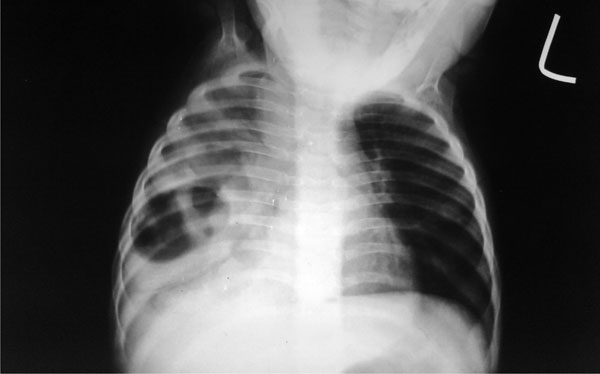|
|
|
Indian Pediatr 2014;51: 840 |
 |
Cavitary Pulmonary Tuberculosis Mimicking
Congenital Cystic Adenomatoid Malformation in an Infant
|
|
Sudeep HC Kumar and H Ramesh
Department of Pediatrics, JJM Medical College,
Davangere, Karnataka, India.
Email: [email protected]
|
|
Cavitary lesions due to pulmonary tuberculosis are very rare in infants,
although these may be found in older children and adolescents [1]. We
report a six-month-old girl who presented with history of recurrent
episodes of respiratory infections, failure to gain weight, rapid
respiration and feeding difficulty since 3 months of age. Failure to
thrive, respiratory distress, clubbing and decreased air entry in right
infra mammary region with coarse crepitations were evident on clinical
examination. Full Blood count revealed anemia and neutrophilic
leucocytosis. Chest X-ray revealed a large cystic lesion in right
middle and lower zone (Fig. 1). With provisional diagnosis
of Congenital cystic adenomatous malformation (CCAM)/congenital lobar
emphysema (CLE) with consolidation/staphyolococcal pneumatocele,
antibiotics and supportive treatment were initiated. On High resolution
computerised tomography of thorax, CCAM/CLE were ruled out, and features
of pneumatocele with endobronchial obstruction of bronchi with mucus
plugs on right side were found. Bronchoscopy revealed granulation tissue
in the bifurcation of right main bronchus, distal end of right middle
lobe bronchus and right lower lobe bronchus. Mother had history of
chronic cough and intermittent fever of 5 months duration for which she
had received antibiotics and bronchodilators. Her chest X-ray
revealed similar cavitary lesion in the lower zone of right lung.
Acid-fast-bacilli were found in her sputum. Both infant and mother were
put on anti-tuberculosis treatment, and on six month follow up child had
gained 3 Kg weight. Her symptoms had disappeared with radiological
clearance of lesion.
 |
|
Fig. 1 Chest X-ray showing cavitary
lesion in right lower zone.
|
We emphasize to consider tuberculosis in any infant
presenting with chronic respiratory symptoms with failure to thrive.
Cavitary lesion in lung is a rare presentation of tuberculosis in
infants. Contact tracing is crucial in arriving at diagnosis for early
treatment and good outcome.
Acknowledgements: Dr G Guruprasad, Dr CR
Banapurmath.
Contributors: Both authors contributed to case
work-up and drafting the manuscript.
Funding: None; Competing interests: None
stated.
References
1. Bolursaz MR, Khalilzadeh S, Baghaie N, Mehrian P,
Ghafaripoor H, Aghahosseini F, et al. Clinical and radiographic
findings of pulmonary tuberculosis in infants; J Compr Ped.
2013;3:170-4.
|
|
|
 |
|

